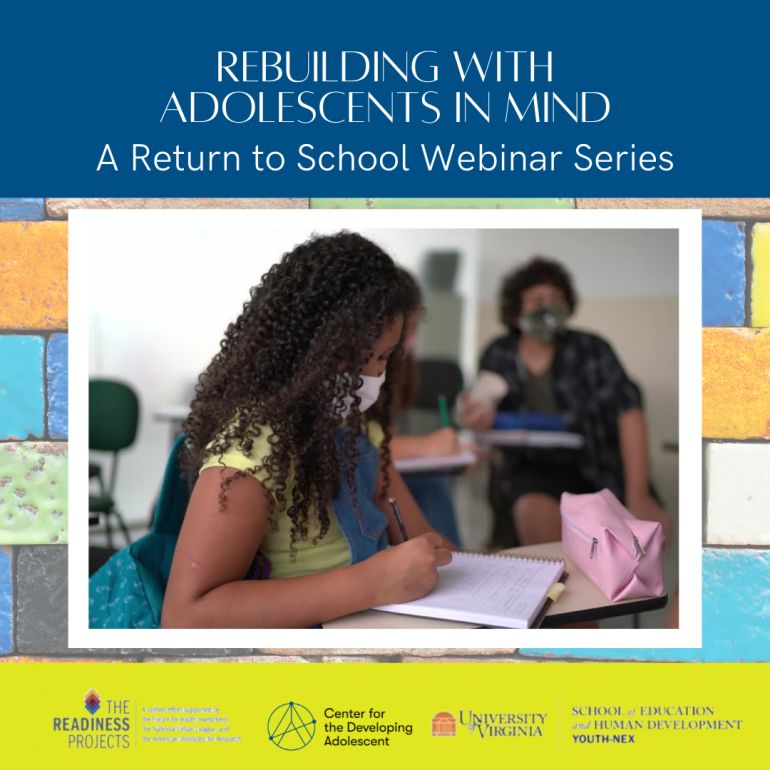Whether returning to the classroom for the first time since early 2020, transitioning from hybrid back to a regular schedule, or returning to a routine with less disruption, this fall will be an inflection point for the adolescents in our communities. To determine some of the best ways that adults can support adolescents as they return to school and other in-person activities this fall, we partnered with Youth-Nex and The Readiness Projects to host a four-part webinar series. Here’s a recap of how that went:
Webinar 1: COVID-19 & Adolescent Development—What Developmental Science Tells Us About Supporting Reentry
In the first webinar of the series, our co-executive director, Dr. Andrew Fuligni discussed how we can better support the developmental needs of adolescents as we rebuild. One key takeaway from the discussion is this: Adolescence is a key period of learning and exploration in so many ways, not just academic or school learning. When we recognize and support that learning and exploration, we will see benefits to youth both inside and outside of the classroom, as well as benefits to our families and communities.
Another key takeaway is the importance of focusing on a healthy transition back to school, instead of focusing on catching up quickly. The reality is that it took many months to transition to social distancing and the hybrid model within schools. We should expect the same length (if not longer) for a transition back to in-person learning.
Webinar 2: Everything Different? Act Different! Building Forward Together
In the second webinar of the series, Merita Irby from The Readiness Projects discussed how communities can work together to intentionally invest in young people, and build on their determination.
“It’s worth thinking about this idea of what it takes to really unleash the creativity, the determination, and the power of young people to work with us and alongside us in these times to be able to create change,” said Merita Irby.
So, how do we do this? One way is to reconsider the way we view learning and school, and create an understanding that it is important to think about learning not only within a typical school day context, but also within the context of summers, before and after school hours, and overall time spent outside of the typical school day, all of which contribute to a young person’s experience.
Webinar 3: Designing Educational Experiences with Adolescents in Mind
In the third installation of this webinar series, panelists discussed key factors that educators in and out of schools need to be focused on as schools reopen in the fall. One key takeaway is that students have all had different learning experiences over the past few months and as a result, it’s important to meet them where they are, instead of having set expectations of where they should be. Additionally, for a lot of students, learning has been happening at home or in their communities, and it is important to see that learning as an asset.
Another key takeaway from this webinar is to acknowledge the shift in roles that adolescents may have experienced throughout the pandemic. Some youth may have experienced more independence and responsibility throughout the pandemic, such as having to get a job or taking on more responsibility within the house. Other youth may have experienced less independence. Nevertheless, it is important to remember that these changes are part of the shifting roles and identities that youth are trying to navigate as they come back into classrooms and other in-person activities in the fall.
Webinar 4: Learning from the Experts—A Youth-Led Youth Panel
Finally, we concluded the webinar series with a youth panel, to hear from young people about their experiences firsthand, and their recommendations for adults to support their transition back to in-person learning. Panelist members Victor Davis, Corrine Chau, Primo Lagaso Goldberg, Sarvasrika Singh, and Arnez Barksdale, along with moderator and YR Media journalist Lucy Branum, discussed the ways they found joy throughout the pandemic, their greatest challenges and struggles, and what they want adults to know about their experiences in preparation for the fall.
The panelists also talked about the things they want to carry forward from this period throughout the pandemic. One common theme throughout their responses was the desire to carry the lessons learned forward as we return to in-person learning.
“We’ve come to terms with and realized a lot of things about the way our society operates as a result of the pandemic,” said Primo Lagaso Goldberg. “We need to recognize what these are and moving forward, we need to address them. We can’t go back to the way things were before, now that we’ve seen how bad things are.”
Ultimately, it is absolutely crucial to support adolescents as they transition back to in-person school and activities in the fall. Though it seems like the answer is to return to “normal,” the reality is that we need to recognize the way young people’s experiences have changed throughout the pandemic, and adapt accordingly.
Thanks to everyone who tuned into this webinar series this month. We hope you enjoyed these discussions, and that they’ll be helpful as we work to return to a better “normal.” To see each of the session recordings and additional resources, visit developingadolescent.org/topics/item/rebuilding-with-adolescents-in-mind.



_350_233_80_c1.jpg)